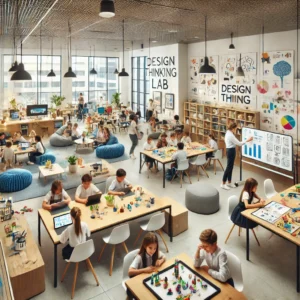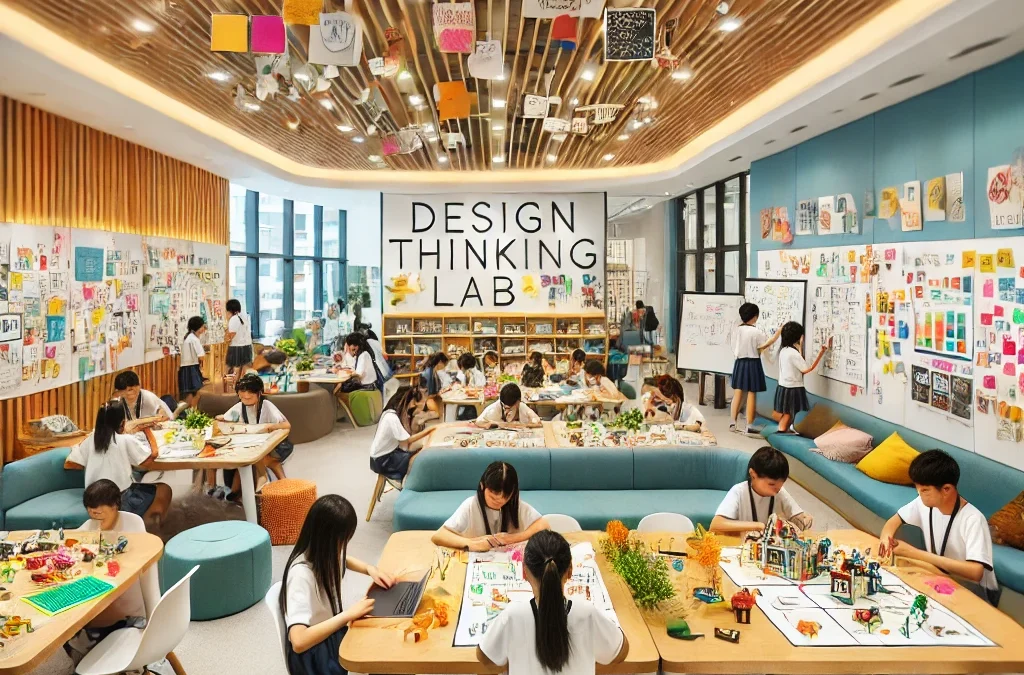Design Thinking Labs: Today, traditional education is no longer enough to prepare students for the challenges of tomorrow, schools must embrace innovative approaches to learning. One such approach is design thinking—a creative problem-solving method that encourages curiosity, collaboration, and innovation. Investing in Design Thinking Labs is not just a trend; it is a necessity for schools that want to empower students with essential 21st-century skills.
What is Design Thinking?
Before we dive into why schools should invest in Design Thinking Labs, let’s break down what design thinking actually means. It is a human-centered approach to solving problems by understanding users’ needs, brainstorming solutions, testing ideas, and refining them based on feedback.
The five key stages of design thinking are:
- Empathize – Understand the needs and challenges of the people you are designing for.
- Define – Clearly identify the problem that needs to be solved.
- Ideate – Brainstorm multiple creative solutions.
- Prototype – Create simple models or sketches to test ideas.
- Test – Gather feedback and refine solutions.
This process is widely used by top companies like Apple, Google, and Tesla to create innovative products. So, why not introduce it in schools to prepare students for the future?
1. Encouraging Creativity & Innovation
Most traditional classrooms focus on rote learning and standardized tests, leaving little room for creativity. Design Thinking Labs provide an open, interactive space where students can think outside the box and develop their creative potential.
- Instead of memorizing facts, students learn by doing—experimenting, failing, and improving.
- They can build prototypes, test ideas, and collaborate with peers on real-world challenges.
- This hands-on approach helps students develop confidence in their creative abilities.
- By fostering creativity, Design Thinking Labs encourage students to become inventors rather than passive learners.

Design Thinking Labs
2. Building Problem-Solving Skills
Life is full of challenges, and the ability to solve problems effectively is one of the most important skills a person can have. Design thinking teaches students to approach problems with a solution-oriented mindset.
- Instead of seeing failure as a setback, students learn to view it as a stepping stone to improvement.
- They develop resilience and adaptability—essential traits for success in any field.
- By working on real-world projects, students learn to analyze issues critically and come up with innovative solutions.
- This mindset shift from “problems” to “opportunities” can transform the way students approach learning and life.
3. Preparing Students for Future Careers
The future job market is changing at an unprecedented pace. Many traditional careers are being replaced by automation and artificial intelligence, while new roles are emerging that require creativity, critical thinking, and collaboration. Artificial intelligence and robotics courses play a crucial role in preparing individuals for these new opportunities
- Top companies are looking for employees who can think creatively and solve complex problems.
- Design Thinking Labs equip students with skills that will help them thrive in careers that do not even exist yet.
- Whether they become entrepreneurs, engineers, designers, or educators, students will have the mindset and skills needed to excel.
- Investing in Design Thinking Labs today is an investment in future-ready students.
4. Promoting Collaboration & Teamwork
In reality, success is rarely achieved alone. Whether in the workplace or in personal life, collaboration is key!
- Design Thinking Labs encourage students to work in teams, share ideas, and respect different perspectives.
- They learn how to communicate effectively, resolve conflicts, and build on each other’s strengths.
- By working on projects together, students develop essential leadership and teamwork skills that will benefit them in any career path.
- This collaborative approach prepares students for the real-world work environment, where teamwork is essential.
5. Bridging the Gap Between Theory & Practical Learning
One of the biggest flaws in traditional education is the lack of connection between theory and real-world application. Students often wonder, “Why am I learning this? Where will I use it?”
Design Thinking Labs help bridge this gap by:
- Enabling students to use classroom knowledge for actual world issues.
- Giving them hands-on experience in STEM (Science, Technology, Engineering, and Math) subjects.
- Encouraging them to experiment, test, and refine their ideas in a safe, supportive environment.
- When students see the practical impact of their learning, they become more engaged, motivated, and excited about education.
6. Boosting Confidence & Leadership Skills
Many students hesitate to share their ideas because they fear being wrong. Design Thinking Labs create a culture where mistakes are embraced as part of the learning process.
- Students gain the confidence to express their thoughts and take risks.
- They develop leadership qualities by guiding their peers through brainstorming and problem-solving sessions.
- As they see their ideas come to life, they feel a sense of achievement, boosting their self-esteem.
- When students believe in their abilities, they are more likely to take initiative and become future leaders.
7. Making Learning Fun & Engaging
Let’s face it—many students find traditional learning methods boring. Endless lectures, repetitive worksheets, and memorization do not inspire curiosity or excitement.
Design Thinking Labs bring fun and excitement into learning by:
- Encouraging students to work on hands-on projects.
- Allowing them to use technology, art, and storytelling to solve problems.
- Making learning an interactive and immersive experience.
- When students enjoy what they learn, they become more engaged, curious, and motivated to explore new ideas.
8. Encouraging Social Responsibility & Empathy
At its core, design thinking is about understanding people’s needs and solving problems that matter. This helps students develop a strong sense of social responsibility and empathy.
- They learn to listen to others, understand different perspectives, and design solutions that make a difference.
- Whether working on sustainability projects, community challenges, or accessibility solutions, students become aware of how their skills can positively impact society.
- This mindset helps shape them into responsible, compassionate individuals who want to make the world a better place.
Conclusion: The Future of Education Lies in Design Thinking
The world is evolving, and so should education. Schools that invest in Atal Tinkering Labs and Design Thinking Labs are not just adding another classroom; they are creating a new way of learning—one that prepares students to be thinkers, innovators, and problem-solvers.
By fostering creativity, collaboration, and critical thinking, Design Thinking Labs help students develop skills that are essential for the future. They bridge the gap between theory and practice, make learning more engaging and fun, and empower students to solve real-world problems.
Now is the time for schools to take action. Investing in Design Thinking Labs today is an investment in the future of education and the success of every student.
If we want our children to thrive in a world of constant change, innovation, and new possibilities, we must give them the tools and mindset to lead that future. And it starts with design thinking. Design Thinking in Schools plays a crucial role in equipping students with these skills
Contact our team at Techradiance to set up a Design Thinking Lab in your school in Delhi and beyond!

